- 2024 BOAT BUYERS GUIDE
- Email Newsletters
- Boat of the Year
- 2024 Freshwater Boat and Gear Buyers Guide
- 2024 Boat Buyers Guide
- 2024 Water Sports Boat Buyers Guide
- 2024 Pontoon Boat Buyers Guide
- Cruising Boats
- Pontoon Boats
- Fishing Boats
- Personal Watercraft
- Water Sports
- Boat Walkthroughs
- What To Look For
- Watersports Favorites Spring 2022
- Boating Lab
- Boating Safety
- Ultimate Boat Giveaway


The Excitement of Running a P1 Offshore Race Boat
- By Charles Plueddeman
- November 16, 2023
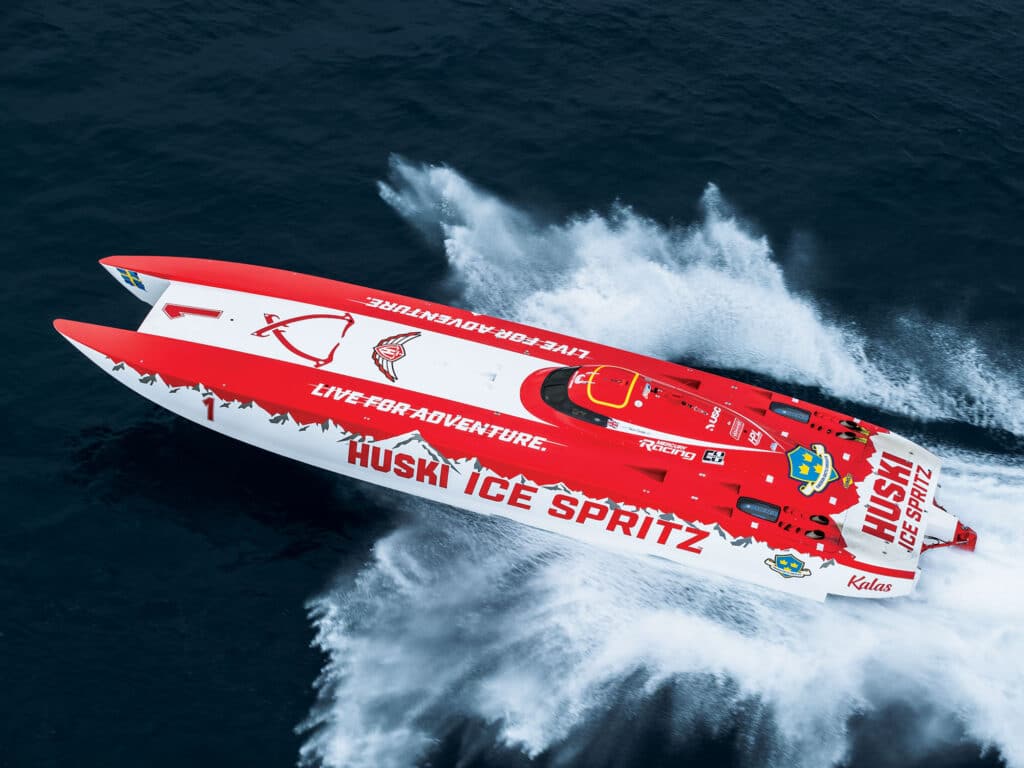
In this age of 70 mph pontoons , 90 mph center-consoles and 150 mph sport cats, it’s pretty easy to experience eye-popping velocity on the water. So, there you are, the wind flapping your cheeks as you hold that throttle to the stop, one watering eye on the speedo as you bump the trim hoping to squeeze out the last bit of speed it will take to be the first boat to the poker-run card pickup. Maybe you even imagine that’s Reggie Fountain , Steve Curtis or Shaun Torrente at the helm of the boat you are pursuing, and instead of a king of hearts, there’s a big trophy waiting at the finish line. Well, dream on, Speed Racer. You’re going fast, but you are not racing, and your production-built motorboat is no race boat.
Steve Curtis throttles a real race boat. The Victory catamaran Huski Chocolate carried Curtis and drivers Travis Pastrana and Brit Lilly to the 2022 UIM Class 1 championship in the Powerboat P1 Offshore series. Last summer, we met Curtis and this boat, now rechristened Huski Ice Spritz, at the Mercury Racing Midwest Challenge in Sheboygan, Wisconsin, the fourth event on the five-race 2023 P1 schedule. The boat is owned by SVEA Racing Inc., based in Stuart, Florida, regarded as the benchmark in professionalism and experience in Class 1 and led by technical director Gary Stray, director of operations Scott Colton and crew chief Patrick Cleaveland.
Curtis, a 59-year-old Englishman and the son of Cougar Powerboats founder and racing catamaran innovator Clive Curtis, claimed his first Class 1 world championship in 1985 in Key West when he was 21 years old. In his career, Curtis has throttled more than 20 world champions. Who would be better to show us under the cowl of a Class 1 race boat than the acknowledged master of throttling racing cats?
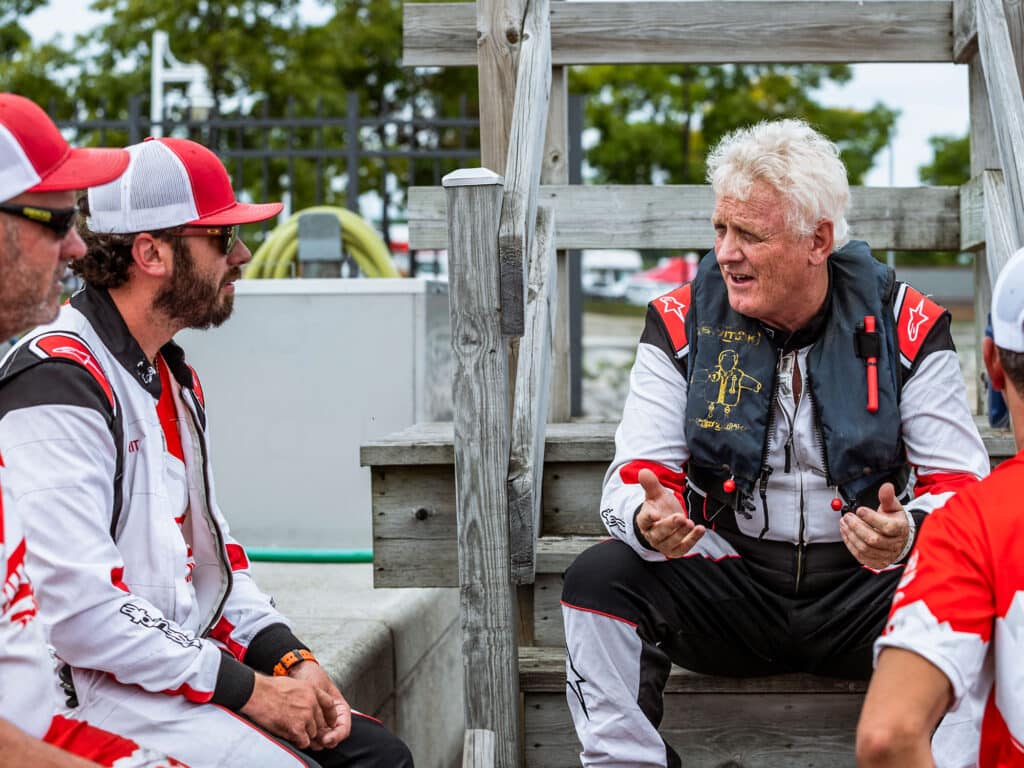
Class 1 is the premier category of international offshore powerboat racing. A P1 Offshore event can include a number of classes, but only the Class 1 Championship is sanctioned by the UIM (Union Internationale Motonautique), the world governing body for all powerboating activities. Basic rules for Class 1 dictate a minimum boat length overall of 12 meters (about 39 feet) and a minimum weight of 5,400 kilograms (just over 11,900 pounds). There have been seven boats in the Class 1 field in 2023, ranging in length from the 43-foot Skater Monster Energy/MCON to the 51-foot Mystic dfYoung. The Huski Ice Spritz/SVEA Victory is 47 feet length overall, with a running surface of 41.5 feet, according to Curtis, and a 12-foot beam. Curtis explains that the bigger boats often have an advantage in rough conditions, but the smaller boats can be nimbler in a current on flatter water in a tight, multiturn closed course—the 5-mile course at Sheboygan had 10 turns.
“Courses have become smaller to make the event more spectator-friendly,” Curtis says. “We used to run 40-mile laps and 200-mile races.”
The age of the Class 1 fleet is also surprising. Huski Ice Spritz/SVEA was built in 2007 by the Victory team in Dubai to a Michael Peters design.
“The boat has been rebuilt and repowered a number of times,” Curtis says. “I believe it was originally powered by Lamborghini V-12 engines. The boat has been crashed and repaired. The entire deck has been replaced, and the running surface adjusted as the engine package has changed.”
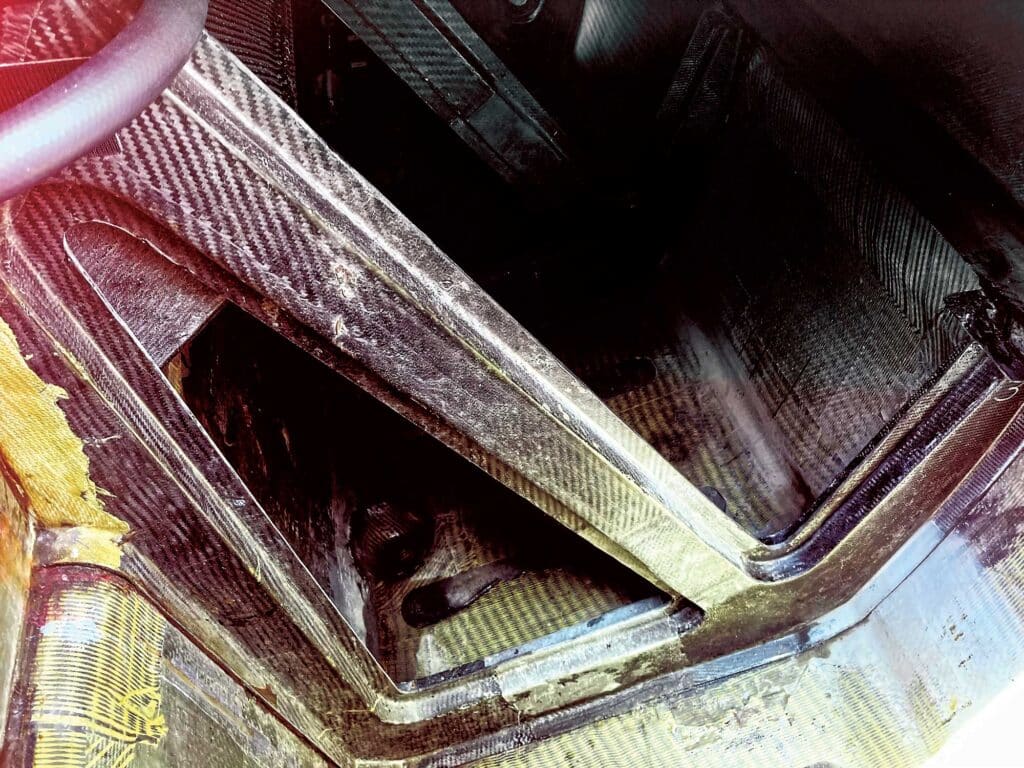
Carbon, Of Course
The overall theme of a race boat is that every element is functional, and this is the key difference between Huski Ice Spritz and your go-fast rig. Speed and safety are all that matter. The hull and deck are laid up with a combination of carbon fiber and Kevlar composite, with foam coring of various density. Bulkheads are carbon fiber, molded in a combination of triangulation and U-channel shape, and bonded within the hull. Each sponson has a pair of steps that are about 1.5 inches deep and a single strake. The tunnel between the sponsons is designed to trap and compress air, which lifts the boat at speed. The tunnel is about 33 inches deep at the bow but only 22 inches deep at the transom.
A V-hull boat could run in Class 1, but the catamaran offers a significant advantage, according to Randy Scism, who helped establish the Victory team as a force in offshore racing before returning to the United States in 1998 to start performance boatbuilder Marine Technologies Inc.
“A comparable V-hull boat will be 20 to 30 mph slower at top speed,” says Scism, who designed the 48-foot MTI Class 1 cat XInsurance/Good Boy Vodka. “In some conditions, it might corner better, but it could never make up the difference in total lap time. The air cushion under a cat can carry 30 to 35 percent of the boat’s weight, so the bottom is not even touching small waves and chop.”
Builders seek to produce a boat that is significantly below the class minimum-weight specification. This allows each team to make weight using lead ballast—water ballast is not allowed—that can be positioned right on the stringers to keep the center of gravity as low as possible to enhance handling and help trim the boat. Weight, either lead bars or bags of lead shot, can be placed aft to lift the bow in calm conditions or forward to hold the bow down in rough water. Fuel tanks are located directly on the boat’s center of balance so that balance does not change as fuel is consumed. At race venues, a crane fitted with a scale lifts the Class 1 boats from the trailer to the water; this way, each boat is weighed every time it goes in and comes out of the water to prevent cheating.
At Class 1 speeds, aerodynamics becomes critical. The boats literally fly over the water, and the deck is flush with the top of each sponson. The enclosed cockpit is a teardrop blister, hatch latches and cleats are carefully recessed and faired, and air intake is accomplished with low-drag NACA ducts. When conditions are ideal, these huge boats appear to levitate with a grace that belies the brutal thrust required to reach speeds that can exceed 160 mph on the open ocean.
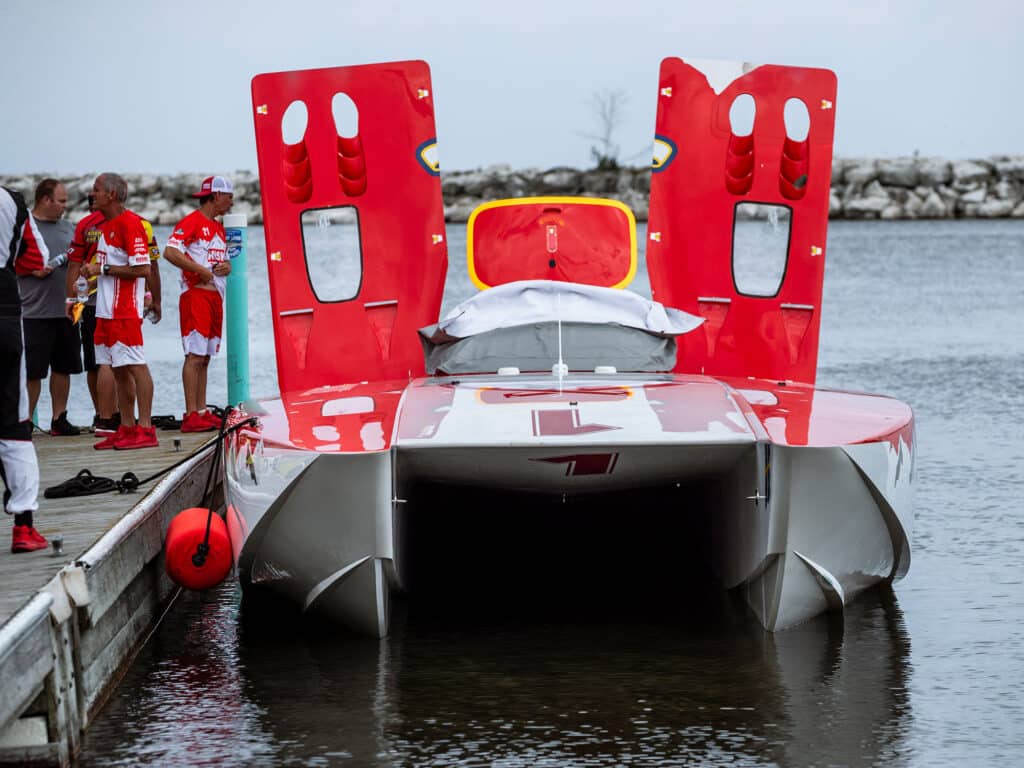
Prescribed Power
There are no surprises below the engine hatches of a Class 1 boat. Since P1 led a revival of the class in 2019, the Mercury Racing 1100 Competition engine has been standard power, a spec engine for the class. The 9.0-liter V-8 engine features Mercury Racing QC4 quad-valve cylinder heads and is boosted by twin turbochargers. Power output is 1,100 hp and 1,100 lb.-ft. of torque per engine on 93-octane pump gasoline. Each big V-8 turns 6,000 to 6,500 rpm. The transmission is the stout model designed for the Mercury Racing 1750 engine with a stronger input shaft and internal components.
“Before the switch to the Merc 1100, we were running engines making 1,850 to 2,000 hp at 7,500 rpm,” Curtis says, “and top speeds pushed 190 mph. Those engines needed a rebuild after each race.”
The point of a specified engine for the class is to reduce cost and ensure power parity among teams with unequal resources. With that in mind, the engines are tightly controlled. Teams are not allowed to make any adjustments or modifications to the engines. With the exception of the valve covers, the engines are sealed with special fasteners. At the beginning of each race weekend, the Mercury Racing support team delivers propulsion control modules (PCM) to each team. The PCM units are painted bright yellow so they are easy to identify. Mercury Racing also installs a data logger on each engine.
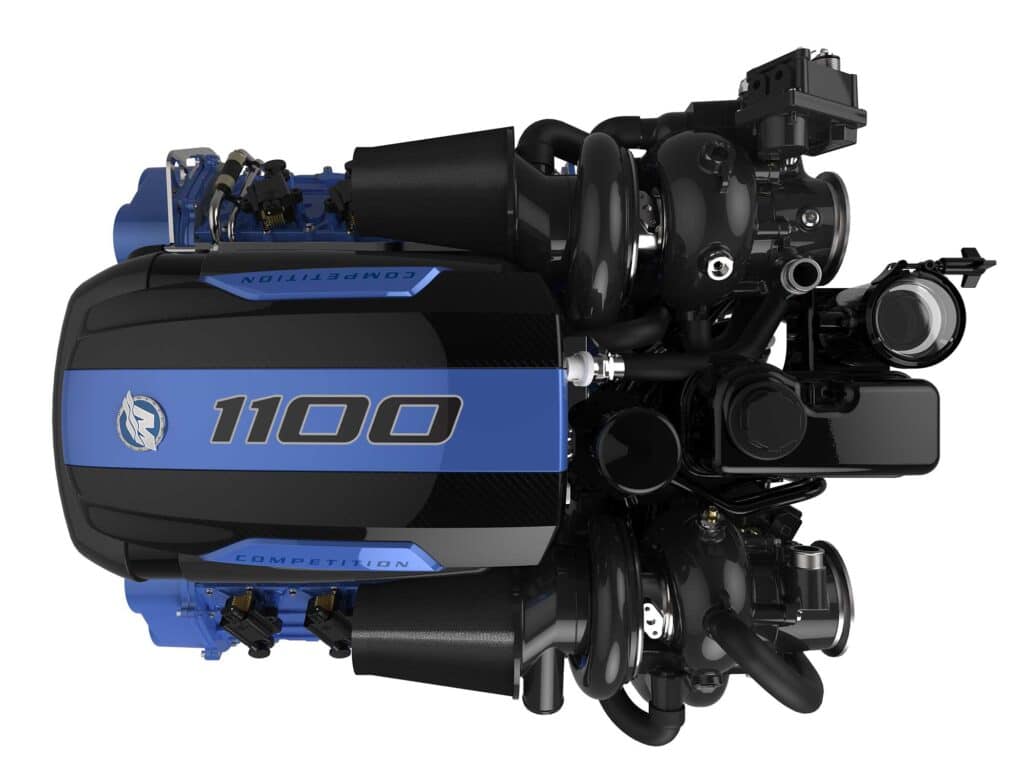
“After every practice and every race, we download the data to make sure it makes sense and that nobody has tweaked on the engines and turned the power up,” says Steve Wynveen, Mercury Racing manager of development engineering. “The idea of Class 1 now is that winning is dependent on driving and boat setup, not on who has the most money to throw at an engine.”
The expectation is that if teams don’t abuse these engines by constantly banging into the rev limiter, each can last the season with just basic maintenance. Teams will put between two and three hours of run time on the engines at each race weekend. Teams are free to install their own PCM for testing between races.
The Huski Ice Spritz/SVEA team engineered a number of quick-disconnect fittings that allow it to remove an engine in about 20 minutes, according to Curtis. This team pulls its engines after each race for maintenance and inspects the bilge and engine mounts below the engines. Typical maintenance includes an oil and filter change, checking the valve lash and adjusting with shims, a compression and leak-down test, checking the turbocharger waste-gate adjustment, and torquing all fasteners and clamps.
Six of the boats in this Class 1 fleet use surface drives based on a BPM model to put power to the water. The Italian drive only articulates in the vertical plane, which provides a limited range of trim, generally less than 15 degrees or, according to Curtis, about 1.5 inches at the propeller. The prop is located about 58 inches abaft the transom. A drop box located on the exterior of the transom allows teams to quickly change gear ratios to best match engine torque to the prevailing conditions. Curtis explains that on today’s short courses, acceleration out of turns is often more important than top speed. Teams using a surface drive are limited to three prop sets but have unlimited gear ratios. Steering is accomplished by a center-mounted rudder—a knife-sharp polished stainless Italian Flexitab model on Huski Ice Spritz—and teams can change rudders based on water conditions.
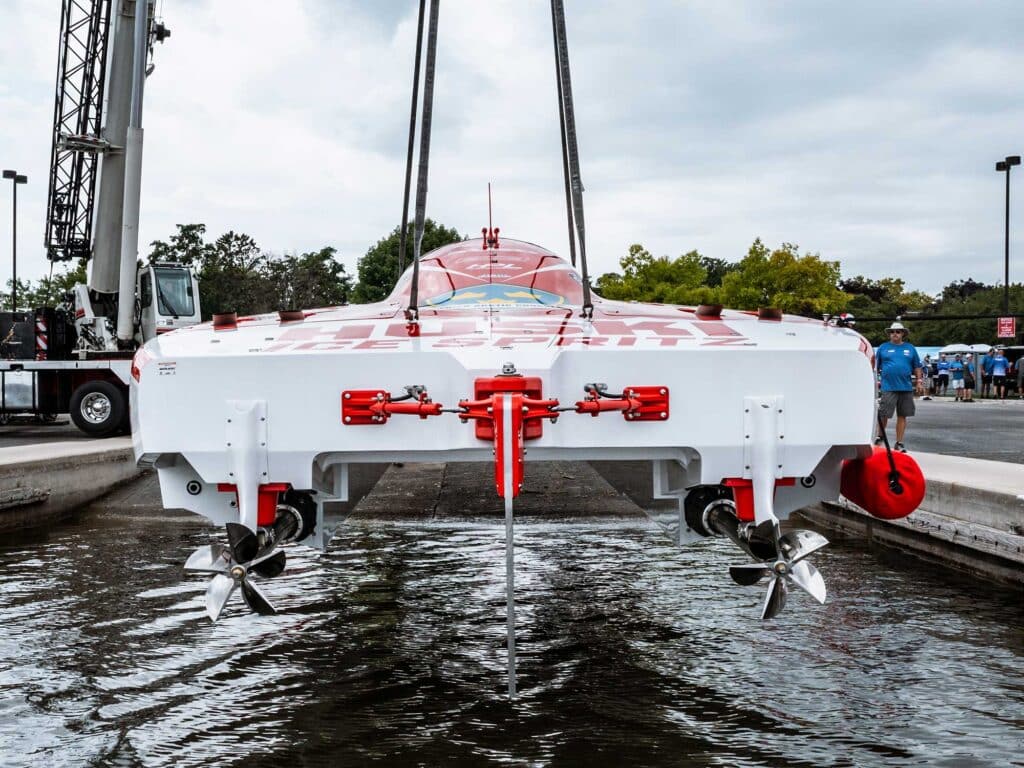
A sterndrive is also permitted in Class 1, but if the sterndrive can steer, the boat is not allowed to use a rudder. The MTI XInsurance/Good Boy Vodka boat is rigged with modified Mercury Racing M6 sterndrives. Trim is retained, but the skegs are cut off and steering is locked. The boat is equipped with a rudder. Teams running sterndrives are allowed an unlimited number of propellers.
“The problem with trying to steer these boats with the sterndrives is that when you turn the drive, one prop is pushed into water and the other into the air coming through the tunnel,” Scism says. “The prop in the air loses thrust. You want to keep both props centered behind the sponsons. I prefer to use the M6 drives for the added trim authority. That drive is plenty rugged for these engines.”
Read Next: How to Boat Safely at Any Speed
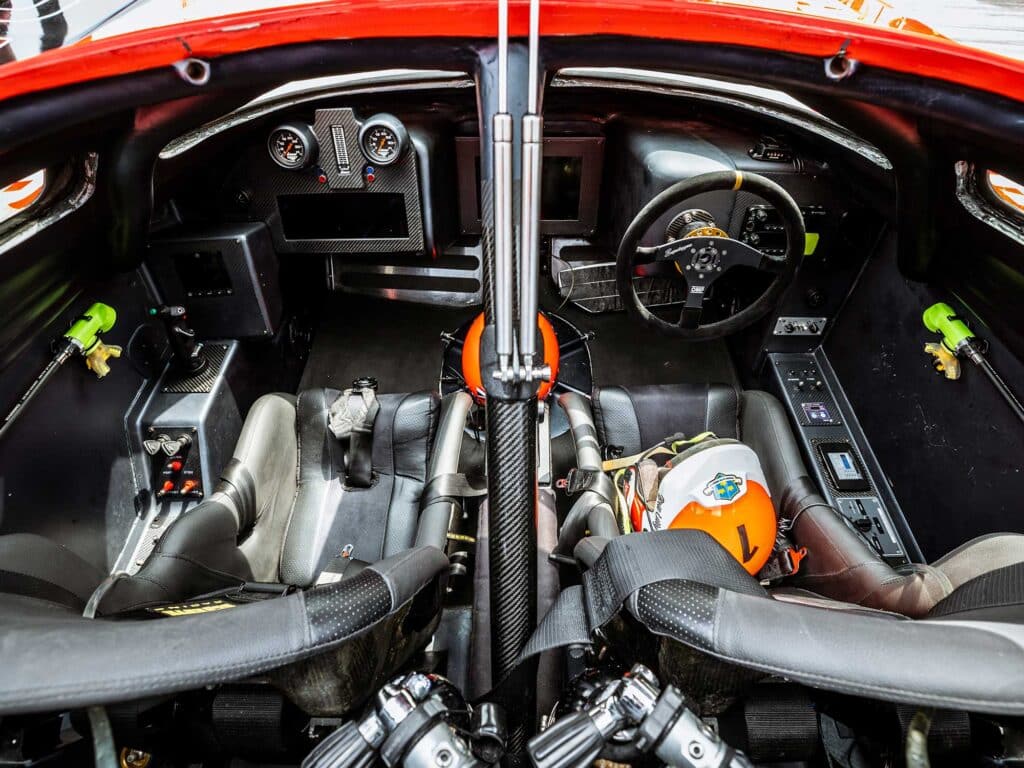
Curtis throttles with his right hand gripping a pair of Mercury Zero Effort controls topped with red plastic knobs molded to the shape of his hand. To his left is a fixed, molded grip with radio/intercom control buttons, trim control, and a button to change the screen display. Curtis can communicate with his team using VHF and UHF radios, and a cellular connection. Below is a pair of Mercury ignition keys, which we were surprised to see.
“When we went to the standard Merc 1100 engines, we wanted to retain the entire stock wiring harness to prevent any sort of tampering,” Curtis says. “So, there are the keys, just like on your fishing boat. It was the easiest solution.”
Facing Curtis are a pair of Livorsi turbocharger boost gauges, a Livorsi trim indicator, and a multifunction display usually showing tachometers. In the center of the dash is a Garmin MFD split between navigation and a rearview camera. The driver sits before a quick-release steering wheel with a lap counter on top of the dash, which will also display a yellow-and-red flag signal from race control.
I wish I could describe the sensation of driving Huski Ice Spritz at speed while looking through the slit of a windscreen. But as it turns out, there is not enough liability coverage or legal cover to ever make that happen. Scism says MTI will build you a new 48 Race model to Class 1 specs, with a price tag of $2.2 million to $2.4 million with power. A $500,000 budget will cover a bare-bones Class 1 team for a season, Curtis says, with a well-financed team spending more than $1.5 million. SVEA Racing Inc. brings a crew of 10 to each race with a 70-foot race trailer, a tilting boat trailer and its Kenworth hauler, and a world-champion throttleman. They are not going to a poker run.
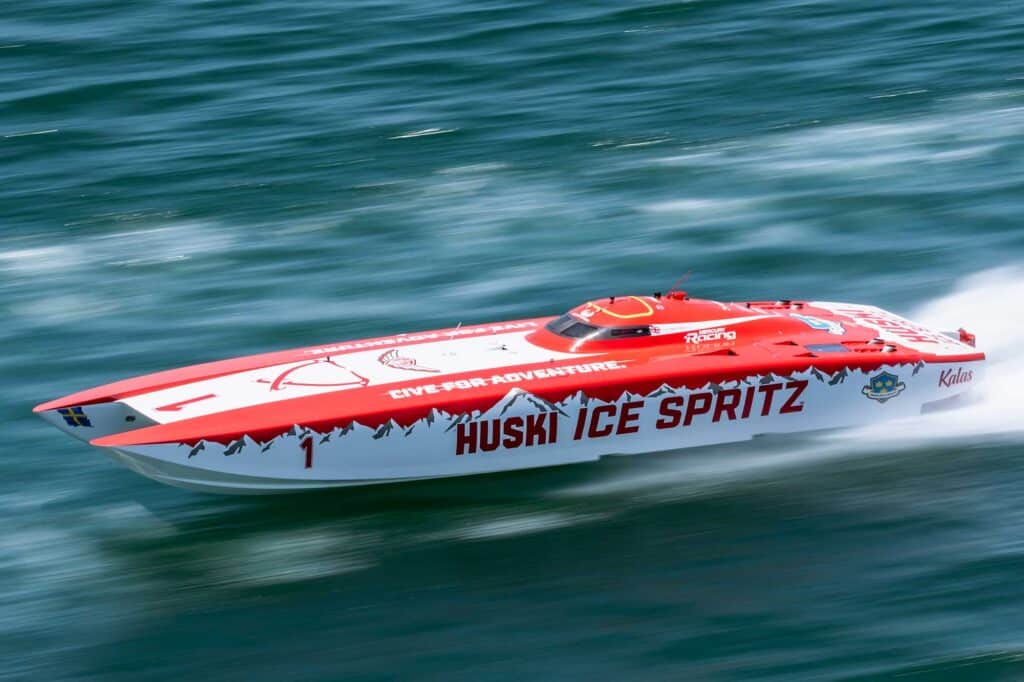
Safety First
When Steve Curtis won his first Class 1 championship, he was standing in an open cockpit. “There was very little concern for safety in those boats,” Curtis says. “If you stuffed the boat, it was very likely you’d be killed.”
Today the driver and throttle work in an enclosed cockpit that is all business. This is not your pleasure boat—there is no Alcantara upholstery, no bass-pumping audio system, and no LED-illuminated drink holders. Cockpit entry is through a hatch secured with four sliding bolts like a bank vault. In Huski Ice Spritz, Curtis throttles from the port seat, and the driver is at the wheel to starboard. Deep bucket seats have 2 inches of suspension travel, and the crew is strapped securely in place. “During a race, it can actually get rather violent in here,” Curtis says. “It’s not very noisy, but there is a lot of vibration, even in smooth water, because the boat is so rigid. We can feel pretty beat up after a race.”
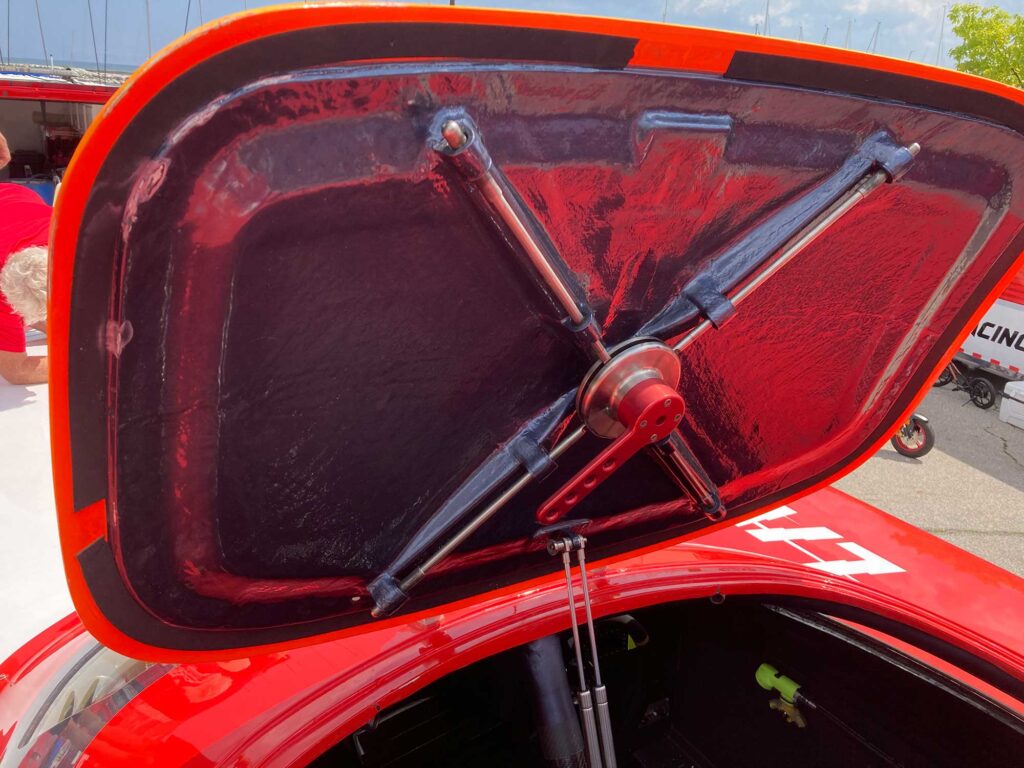
A cage of carbon channels surrounds the cockpit, which Curtis says is backed by a very thick bulkhead. Crush zones around the cockpit are designed to absorb energy on impact. The interior is raw and black, with no thought of cosmetics. The forward portion of the cockpit structure is formed by a ¾-inch-thick polycarbonate shield modeled after a fighter-jet canopy. The clear portion is minimized for further crew protection. There’s an emergency escape hatch in the floor for egress if the boat flips. The driver and throttle have a 10-minute emergency air supply.
- More: Performance Boats
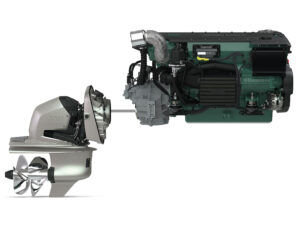
Volvo Penta D6 Diesel DPI
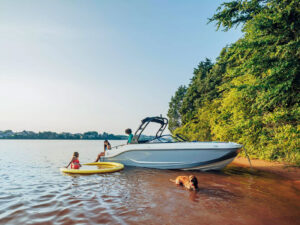
Bayliner 2024 D Series Deckboats Debut
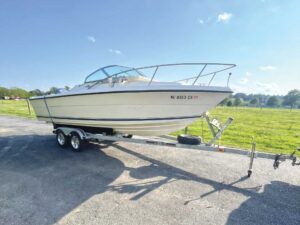
Is Your Trailer Right for Your Boat?
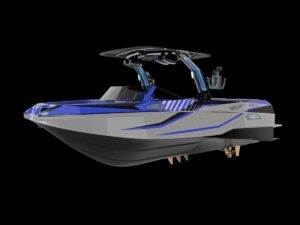
Genesis Marine Technologies 24: Our First Impression
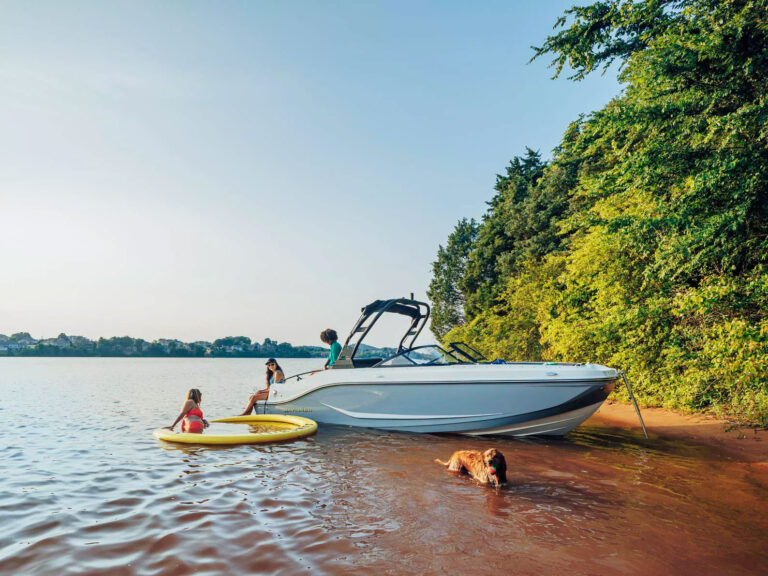
How to Choose a Trailer Winch

Best Non Skid Boat Deck Paint

- Digital Edition
- Customer Service
- Privacy Policy
- Terms of Use
- Cruising World
- Sailing World
- Salt Water Sportsman
- Sport Fishing
- Wakeboarding
Many products featured on this site were editorially chosen. Boating may receive financial compensation for products purchased through this site.
Copyright © 2024 Boating Firecrown . All rights reserved. Reproduction in whole or in part without permission is prohibited.
P1 Offshore;
Powerboat P1 is the fastest growing marine motorsport series in the world and has a long term commitment to growing and developing the sport of power boating at all levels. The Powerboat P1 team works closely with the sports governing bodies, the UIM, APBA and the IJSBA. P1 has delivered more than 85 world championship events in over twelve different countries for more than a decade.
Cookie Policy
Contact info.
- Address: 2320 Clark Street, Suite A1 Apopka, FL 32703 United States
- Phone: +1 407 985 1938
- Email: [email protected]

Cocoa Beach
Fri 17 - Sun 19, May
Lake of the Ozarks
Thu 30, May - 01, Jun
Fri 09 - Sun 11, Aug

Fri 23 - Sun 25, Aug
Fri 13 - Sun 15, Sep
St. Petersburg
Fri 18 - Sun 20, Oct

MCON Monster Energy race boat at Cocoa Beach

DF Young team in race action at Sheboygan

Racing off the iconic St. Pete Pier

Class 1 Boats racing at the Sarsota Grand Prix off Lido Beach

Drone Shot of the pit Area by the Van Wezel, Sarasota
Tue jan 09 2024, powerboat p1 unveils 2024 p1 offshore and class 1 race calendar.
- P1 race events to be part of the APBA national championship
- New end of season dates for Sarasota and St. Pete grand prix
- Mercury Racing event to return to Sheboygan after 2023 success
We love all forms of racing at Monster Energy and entering the UIM Class 1 World Championship and APBA National Championship, as well as the P1 AquaX National Championship, in 2023 genuinely thrilled us with the sport’s amazing and vibrant mix of racing, competition and amazing fan attention, interaction and enthusiasm. We’re thrilled to title sponsor the final round of the national championship. Dave Gowland Monster Energy
Powerboat P1 has today announced its P1 Offshore race calendar for the 2024 season, which sees the series heading to Wisconsin again and returning to favorite venues in Florida. The Sarasota and St. Petersburg grand prix events on Florida’s Gulf Coast move away from their traditional dates around the Independence Day and Labor Day vacations respectively and will provide an exhilarating climax to the season in September and October.
Cocoa Beach on the Space Coast will again host the season opener in mid-May with a weekend of ‘fast boats and cold drinks.’ Thunder On Cocoa Beach will be celebrating its 15th anniversary of staging this event and its Executive Director, Kerry Bartlett will be unveiling special plans to mark this milestone.
In August, racing will return to Sheboygan on the western shore of Lake Michigan for a second year. Sheboygan Area Tourism Zone reported that last season’s inaugural Mercury Racing Midwest Challenge delivered an economic impact of $4.7 million with more than 40,000 attending the three-day festival, and this year’s event in August will be open to all offshore classes. Mayor Ryan Sorenson said: “I am thrilled to welcome back this exhilarating event to the Malibu of the Midwest. It not only showcases our City’s stunning waterfront but also brings together the community in celebration of speed, skill and the thrill of competition. This sense of excitement and unity contributes to the vibrancy of Sheboygan.” City Administrator Casey Bradley added: “This event not only brings a surge of energy to our City but also underscores our commitment to hosting world class events. We appreciate the partnership with Powerboat P1 and Mercury Racing, and we eagerly anticipate the positive impact the race event will have on our local economy and community spirit.”
Another event milestone will be celebrated in September with the 40th anniversary of the Sarasota Powerboat Grand Prix, making it the second longest-running powerboat festival in the United States. For decades the racing has been a unique, prestigious event that brings significant value to the county. Local media reports that it generates millions of dollars in economic impact every year with up to 16,000 room nights, and P1’s national and international television deals showcase the city’s many attractions to an audience of more than 200 million homes. Pete Harvey, Director of Sports at Visit Sarasota County commented: “The Grand Prix draws enthusiastic crowds, capturing the attention of visitors and residents alike. It attracts a diverse range of attendees which generates a sizeable surge in tourism and spending.”
Our goal is to have a fleet of 12 Class 1 boats by 2025. We want to grow the world championship commercially and promote the series both in the United States and internationally to deliver enhanced value for race teams, host venues, sponsors and partners. Azam Rangoonwala Powerboat P1, CEO
The season finale will see the race teams head along the Gulf Coast to St. Petersburg for the Monster Energy St. Pete Grand Prix. Now in its fourth year, the event has quickly become a favorite venue will the racers and it will see the APBA national champions crowned in October. “We’re excited to see one of America’s best waterfront locations selected to host the Powerboat P1 grand prix event,” commented Visit St. Pete/Clearwater President/CEO Brian Lowack. “We love the opportunity to show off the spectacular downtown St. Pete waterfront and award-winning St. Pete Pier as spectators come from near and far to our beautiful destination or tune in on TV around the globe to see some of the most exciting action on water.”
Dave Gowland of Monster Energy said: “We love all forms of racing at Monster Energy and entering the UIM Class 1 World Championship and APBA National Championship, as well as the P1 AquaX National Championship, in 2023 genuinely thrilled us with the sport’s amazing and vibrant mix of racing, competition and amazing fan attention, interaction and enthusiasm. We’re thrilled to title sponsor the final round of the national championship.”
Seven teams are expected to compete in this season’s UIM Class 1 World Championship and races will be staged at the P1 Offshore events. Powerboat P1’s aim is to attract more teams and build the worldwide television audience to return Class 1 to the summit of the sport. “Our goal is to have a fleet of 12 boats by 2025” said P1 CEO Azam Rangoonwala. “We want to grow the world championship commercially and promote the series both in the United States and internationally to deliver enhanced value for race teams, host venues, sponsors and partners.”
“The 2023 offshore season was one of great change and growth” explains Rangoonwala. “This season we will seek further growth by focusing on attracting more competitors, particularly young racers, improving the fan experience, continuing to build our social media audience and broadening the international reach of our TV broadcast deals. Having celebrated our 20th anniversary last year, Powerboat P1 is embarking on its third decade as a promoter and we will continue to design our race events to encourage tourism and enhance the profile of the host venues. Partnerships are at the heart of our business and over the coming months we will be announcing new agreements as well as the renewal of existing sponsorships.”
| Venue | Date | |
|---|---|---|
| Cocoa Beach, FL - Thunder On Cocoa Beach | May 17th - 19th | |
| Sheboygan, WI - Sheboygan Powerboat P1 Grand Prix | Aug 9th - 11th | |
| Sarasota, FL - Sarasota Powerboat P1 Grand Prix | Sept 13th - 15th | |
| St Petersburg, FL - St Pete Powerboat P1 Grand Prix | Oct 18th - 20th | |
For more information on this release:
Roy Mantle Powerboat P1 Management Ltd t: +44 (0)207 935 4977 e: [email protected]
Photo credits:
MCON Monster Energy race boat at Cocoa Beach, credit: David Lando DF Young team in race action at Sheboygan, credit: Ronny Mac Racing off the iconic St. Pete Pier, credit: Ronny Mac Class 1 Boats racing at the Sarsota Grand Prix off Lido Beach Pete Boden Drone Shot of the pit Area by the Van Wezel, Sarasota: credit: David Lando
P1 Offshore in brief
This increasingly important brand within the P1 family encompasses the APBA offshore national championship series, with P1 having been granted by the APBA exclusive rights to film and distribute its offshore events. P1 produces a one-hour television highlights show, featuring Class 1 racing and other APBA classes, broadcast in the United States and internationally. P1 coverage includes live streaming on its Facebook page.
P1Offshore.com
Class 1 in brief
Class 1 is the premier class of offshore powerboat racing in the world and is considered to be one of the most spectacular marine motorsports. A Class 1 race boat has twin inboard 1100HP engines and can reach speed in excess of 160mph. All boats are limited by a minimum weight of 4,950kg.
Class1World.com
You are using an outdated browser. Please upgrade your browser to improve your experience and security.


INSIDE F1H2O
- What is F1H2O?
- The Championship
- The Grand Prix
- Rescue&Safety
The UIM F1H2O World Championship is the 'flagship' international series of single-seater inshore circuit powerboat racing.
Highly competitive, intensely challenging, risky and entertaining, the F1H2O World Championship is the ultimate adrenalin rush and regarded as one of the most spectacular and exciting sports in the world.
The series attracts up to 20 of the world's leading drivers and is a sport that has to be seen to be believed as these diminutive tunnel-hull catamarans enter hairpin turns at over 90mph and top 140mph on the straights.
Picture the scene; 18 to 20 sleek, powerful and lightweight catamarans lining up on the start pontoon. Inside each cockpit sits a lone individual peering through a tiny windscreen. One hand grasps the steering wheel, the other poised over the start button. The tension inside the cockpit is intense as the drivers wait for the crucial start. Beyond the cockpit, an eerie silence descends over the entire arena, all attention fixed on the start.
No sooner does the wait end when 10,000hp of highly tuned brute power bursts into life sending the fleet screaming towards the first corner leaving nothing but a glorious fountain of white spray in its wake.
However, with the thrilling high-speed action comes the risk of ruin as drivers endure brain-numbing G-Forces - their rigs taking hairpin turns at over 90mph while they dice deck-to-deck in often zero-visibility.
Now in its 36th year the four decades of the World Championship have witnessed considerable change and evolution; the seventies and eighties saw multiple promoters and two giant corporations of the sport OMC and Mercury vying for supremacy to be the pinnacle of the sport.
OMC were touting their 3.5litre V8 package that became known as the OZ class, Mercury pushing their 2.0litre engine and called the ON class, the disparity in power would soon lead to bitter wrangling and infighting amongst competitors.
The split came in 1981, FONDA was formed running the ON class engine with the OMC backed PRO ONE run series running the OZ class engine, both rival championships claiming the right to use the title World Championship, a dispute settled by the sport's governing body the UIM later that year awarding the OZ class the accolade.
1984 saw the beginning of yet another twist as safety became a major concern with engine development and increasing power of the V8s taking its tragic toll and signaled the slow demise of the OZ class internationally, ending in 1986.
The door was now opening for the existing FONDA World Grand Prix series to reinvent itself. From 1987 to 1989 there was no official UIM World Championship, and with no challenger, the UIM reinstated the World Championship status and in 1990 the FONDA World Grand Prix Series became the UIM F1H2O World Championship, Mercury's 2.0litre engine the preferred power-plant of the time, the Mercury 2.5litre engine coming in in 2000 and used today.
In 1993 the UIM appointed Nicolo di San Germano as Promoter; his ongoing 30 year tenure has brought stability, a new direction, improved safety and an ever broadening geographic footprint encompassing Europe, the Americas, the Middle East and Asia and with this expansion a growing commercial value.
Over the last 38 years the sport has played out 295 Grand Prix in 33 countries across five continents, 15 drivers have captured the World title, 48 becoming members of the illustrious Grand Prix winners club.
Of the 15 World Champions 8 are multiple title winners; Italy's Guido Cappellini is the most decorated winning 10, Italy's Alex Carella and American Scott Gillman with four, France's Philippe Chiappe, Italian Renato Molinari and American Shaun Torrente with three each, Finland's Sami Selio and Britain's Jonathan Jones with two apiece.
While today's F1H2O catamarans bear a striking resemblance to those in action throughout the 1980's there is a world of difference in terms of driver protection and general safety.
The early boats were constructed from thin plywood with drivers sitting in an open, exposed cockpit with the risk of injury a high probability in the case of an accident.
With safety at the forefront of boat development, British designer and racer Chris Hodges set about improving the situation and constructed a safety cell that was produced from an immensely strong composite material.
Instead of the cockpit being part of the main structure Hodges' capsule was separate and was fitted to the hulls and centre section.
For the first time drivers were actually strapped into their seats. The idea was that if a boat was involved in an accident, the timber hulls could break up and absorb the impact forces while the driver remained well protected inside his cell.
The new device proved itself on several occasions and the U.I.M. called for it to become compulsory, and in the early 1990's Burgess introduced canopies that made cockpits fully enclosed.
In the late 1990's further developments saw the introduction of an airbag in the cockpit that would inflate in a crash to ensure the capsule wouldn't sink before rescue crews could attend.
Over the years boat construction has been developed and today few if any are built of timber, now replaced by modern composites.
In 2023 ten teams and 20 drivers from 12 countries will compete at Grand Prix in Europe, Middle East and Asia for the coveted World title, the prestigious number 1 plate will be carried by the defending World Champion Shaun Torrente driving for Abu Dhabi team.
The Union Internationale Motonautique (UIM) is the world governing body for all Powerboating activities. It is fully recognized by the International Olympic Committee (IOC) and is a member of the Association of the IOC Recognized International Sports Federations (ARISF) and of SportAccord for whom the UIM President serves as President and Board member. The UIM has almost 60 affiliated National Federations. Circuit, Offshore, Pleasure Navigation and Aquabike are among the main disciplines. The UIM has signed a Cooperation Agreement with the United Nations Environment Program (UNEP) to further its range of environmental initiatives and to share expertise.
President: Dr. Raffaele Chiulli General Secretary: Thomas Kurth
Idea Marketing is the sole and exclusive worldwide promoter of the UIM F1H2O World Championship, the UIM-ABP Aquabike World and Continental Championships and the UIM H2O Nations Cup World Series.
The company is the worldwide television and commercial rights holder for all Championships and responsible for all commercial, marketing, television, media and organisational activities.
Founder: Nicolo di San Germano Vice President: Lavinia Cavallero
h2oracing.net f1h2o.com aquabike.net
The F1H2O World Championship is the leading formula in single-seater inshore circuit powerboat racing and was sanctioned by the UIM in 1981.
It is a multiple Grand Prix series of eight events taking place in Europe, the Middle East and Asia.
Points allocated at each Grand Prix count towards the overall World Championship standings.
In addition to the World Championship, points are also allocated for the BRM Pole Position and Team Championships and the Fast Lap Trophy.
A three-tiered qualifying session is run over 60 minutes, the multiple lap Grand Prix run over a minimum 45 minutes, not to exceed 60 minutes.
In 2023 ten teams, 20 drivers from 12 countries plus technicians and support staff will compete for the coveted World title.
DAY 1 Documentation and registration Technical scrutineering Drivers' briefing (compulsory for all team managers, drivers and radiomen of each boat) Free practice Boats and racing equipment (including racing gear of the driver) must be in the pits 24 hours before starting the technical scrutineering
DAY 2 Drivers' briefing (compulsory for all team managers, drivers and radiomen of each boat) Free practice Official Qualifying Podium presentation
Pole position and starting line-ups are determined by a three-tiered qualifying session, Q1, Q2 and Q3 preceding each Grand Prix race. Stateof-the-art timing equipment records the performances of each boat to decide the final classification and starting positions.
Q1 : A twenty-minute session with all boats entitled to run multiple laps at any time during the session, with the 12 fastest progressing into Q2. The times set by those that didn't qualify for Q2 denote their starting positions.
Q2 : After a seven-minute break, the times will be reset and the remaining 12 boats will then run a fifteen-minute session - again they may complete as many laps as they want at any time during that period. At the end of the session the six fastest boats will progress into Q3. The times set by those that didn't qualify for Q3 denote their starting positions.
Q3 : The times are reset and the top six boats from Q2 will run all together for 10 minutes and the arrival order at the finish line will decide their start positions.
If a driver is deemed by the officials to have stopped unnecessarily on the circuit or impeded another driver during qualifying, his times may be cancelled
No refuelling allowed during timed trial.
Every race circuit is different in size, but are generally about 2000 meters in distance. Each circuit has at least one long straightaway and several tight turns, mostly left with one or two right turns.
The turns produce a G-force of up to 4.5 on the driver, which means his weight is multiplied 4.5 times as he makes a tight U-turn at over 100 mph.
Water is a constantly changing unstable unpredictable surface and conditions play a major part in the outcome of each Grand Prix.
With water current and wind conditions varying on every lap and spray being continually showered over the tiny console screen, drivers are quite often driving 'blind' at full speed, mere inches away from their rivals.
In the event of a 'barrel-roll' (capsize), a mandatory air bag installed above the pilot's head will inflate upon contact with water. This enables the cockpit to remain above water until rescue arrives.
All drivers have a self-contained air supply fitted inside the capsule as an added safety features.
LIGHT SIGNALS Each entry must have the electronic time-keeping device and lighting equipment. Compliance is required for scrutineering clearance. Lights signals are used in accordance with these rules to designate specific times or to give instructions to pilots.
Lights and their purposes are as follows:
YELLOW : Reduce speed to 3000 rpm maximum - extreme caution on race course - hold current position - no overtaking - follow pace boat
RED : Race stopped, slow down instantly and return to the start dock, identical to actual black flag.
WHITE AND BLUE caution FLAG : Rescue boats must be given the right of way. A complaint from rescue personnel will be penalised.
Boats that have broken down and pulled to the infield or off the racecourse will be towed to the trailer or the start dock only during a "race stop" condition and if pick-up boats are available.
During the time trials and the race, one crewmember should always remain at signalling area and maintain radio contact with his driver during free practice, timed trials and race.
Each team consists of a manager, two drivers, mechanics, radio coordinator, technical coordinator and equipped with infrastructure such as trailer workshop and welcome marquee.
They should have two catamarans fitted with a 2.5 litre engine and compete at 8 to 10 Grand Prix events in a season.
Imagine this: up to 20 lightweight, 17-foot carbon fibre catamarans hurtling around a racing circuit at speeds topping 220km/h (130mph); all boats are powered by highly tuned V6 outboard engines, each pumping out 400HP at close to 10.000 rpm; they boast an awesome power to weight ratio and weigh in at around 500 kilos.
HULL : Twin sponson, tunnel-hull catamaran
MANUFACTURERS : BABA, Blaze, DAC, GTR, Molgaard, Moore, Victory
HULL MATERIALS : Carbon fibre, Kevlar, synthetic fibre, airex & nomex
LENGTH : 5.10 metres (min)
WIDTH : 2.1 metres (min)
WEIGHT : 550 kg (including residual fuel and oil), the driver with personal equipment, but excluding loose water, circa 380 kilos (not including driver or engine)
FUEL TANK : Carbon constuction, built to accomodate circa 120 litres
ENGINE : Mercury or equivalent outboard engine 6 cylinders 2-stroke
ENGINE CAPACITY : 2.5 litre up to maximum 3 litre
STEERING : Cable with electronic power assist, ratio open to driver preference
GEARBOX : Fixed ratio direct drive
PROPELLERS : As gearbox is fixed ratio, various diameter and pitch from 10.5 by 16 inch upwards (dependant on length of circuit). Forged stainless steel alloy CNC machined
HORSE POWER : circa 400 HP @ 10,000 rpm
TOP SPEED : Over 220 km/h (136 mph)
ACCELERATION : 0-100 km/h (60mph) in circa 3 seconds
BOAT CONTROLS : Hydraulic ram systems controlling engine angle and height operated by a series of switches on steering wheel, dash and foot rest. Foot throttle controlling engine power delivery
SAFETY FEATURES : Cockpit built in composite materials, crash boxes built with energy absorbent foam. HANS head and neck support, airbag, polycarbonate nine millimeter screen and deformable frontal areas to stop penetration in event of accident. Life support system, air bottle and demand valve with helmet attachment used if boat capsizes and driver unable to exit cockpit prior to arrival of rescue boat and team. Inside cockpit the driver is strapped into a carbon hybrid moulded seat with 5 point harness and detachable steering wheel for easy entry and exit. Cockpit canpy latched into closed position for maximum protection against water pressure
The Osprey Powerboat Rescue Team provide rescue services for many powerboat racing events and has a fleet of 6 specialist drop front ambulance boats, 2 of these boats are permanently assigned to providing rescue services to the UIM F1H2O World Championship.
Each boat is manned by four fully trained individuals 2 qualified rescue divers in full kit; 1 qualified helmsman; 1 radio/communications operative; Every member of the crew holds a current Basic Life Support Certificate. Every member of the crew wears a wetsuit as maximum flexibility is required.
Carried on board each boat are the following 2 sets of self-contained breathing apparatus; 1 stabilisation frame in the event of a race boat being upside down; 1 Lift bag to prevent a race boat sinking in the event of extensive damage; 1 fire extinguisher; 1 spine board and stabilisation blocks; 1 oxygen set; 1 radio for communications with the shore based medical team and officials; 1 comprehensive medical kit that contains specialist resuscitation and trauma equipment, details below:
To control catastrophic haemorrhage - CAT tourniquet - ‘Quick Clot’ ACS sponge - 6” Haemorrhage control bandage
To control airway with c-spine control - Suction – hand held with spare spout - Nasopharyngeal airways - size 24 (child) & 28 (adult) -Gels size 4 adult (50-90Kg) size 3 (30-60Kg) - gel sachet on each
To control breathing - Non-rebreather oxygen mask x2 - Ambu-bag, connector & Facemask
To control circulation - Cannula x2, tape, IV giving set, IV fluids – Saline 1000, Gelofusin 500 - Protection and General Kit: gloves, field dressing packs x2, tuff-scissors, stethoscope, saline eyewash, foil blanket, triangular bandage, safety pins, light bandages x2
At each event the team brings A training rig to train and test drivers in escaping from an upturned cockpit. An air compressor to fill diving air cylinders and drivers’ emergency air cylinders carried on the race boats. Generators to provide power A Global Positioning System to ensure the course is laid correctly and to specification.


- Subscribe Now
- Digital Editions

Top 10 powerboat racing icons that helped make boating what it is today
- Top stories
Hugo Peel explores the top ten power-boating events, people and inventions that have influenced today’s sportsboats...
Powerboat racing may seem a world away from the type of cruising most of us do but the sportsboats we enjoy today wouldn’t be half as good as they are without the racers, designers and builders whose heroic efforts helped shape them.
Auto-boat racing, as it was originally known, traces its history back to the late 19th century and for a brief period was even an Olympic sport, with races staged off the Isle of Wight in 1908. However, it wasn’t until the 1960s and 1970s that the sport exploded in popularity as developments in engineering, materials, speed, safety and propulsion really took off.
Racing was the anvil on which these promising technologies were forged. So what are the ten most significant events, inventions and people that have contributed to today’s impressive levels of performance, safety and utility?
While many of these names and events may be unfamiliar now, they are the stuff of legend to all who recall the glory days of British powerboat racing.
1. The Cowes-Torquay-Cowes offshore powerboat race
Many people regard offshore powerboat racing as the ultimate challenge for craft and crew. Arguably the most challenging race of all and certainly one of the oldest is the legendary Cowes-Torquay competition.
Initiated in 1961 by Daily Express newspaper magnate and keen yachtsman, Sir Max Aitken, who foresaw it would help grow the UK marine industry, it bred a string of British and international heroes and brands. This 200-mile race, now known as the Cowes-Torquay-Cowes, and its coveted Harmsworth Trophy, intermittently awarded since 1903, is still the one all top powerboat racers yearn to win.
The marathon Round Britain Powerboat Race started and finished off Portsmouth
2. The marathon Round Britain Powerboat Race
If a 200-mile race sounds challenging, the 1,500-mile endurance marathon that is the Round Britain Race is on an altogether different scale, yet it proved so appealing that it has been run three times over four decades.
The first BP-sponsored race in 1969 comprised ten stages over 1,459 miles and was won by Timo Mäkinen, a champion Finnish rally-driver in Avenger Too propelled by triple Mercury outboards – he averaged 37mph.
The 1984 race was sponsored by Everest double glazing and attracted famous names, including Italian racer/designer Fabio Buzzi driving White Iveco , a single-step GRP monohull with four 600bhp Iveco diesels. Against him was fellow Italian Renato della Valle in Ego Lamborghini , an aluminium-hull craft powered by two ear-splitting 800hp, race-tuned V12 Lamborghinis.
Article continues below…

Test driving the Sunseeker Hawk 38 prototype with Fabio Buzzi

Lamborghini boat: Tecnomar delivers first official ‘Fighting Bull’ branded yacht
Victory went to Buzzi who, after the 157-mile Dundee-Whitby leg, during which White Iveco averaged a staggering 69 knots, dismissed it with shrug saying: ‘In Italy, this is just a cruising boat.’
The race was revived in 2008 attracting a field of 47 raceboats old and new, including a number of production RIBs and sportsboats from companies like Scorpion , Goldfish and Scanner. The favourites included Fabio Buzzi again in his classic four-engined Red FPT , and Austrian casino millionaire Hannes Bohinc in another Buzzi-designed monohull Wettpunkt .
This time the overall winner was a Greek entry Blue FPT navigated by Britain’s Dag Pike, who at 75 years old, was the event’s oldest competitor. Many of the production boats also did remarkably well, showing just how far they have come in recent years.
Steve Curtis MBE is powerboat racing royalty
3. Powerboat racer Steve Curtis
If the Cowes-Torquay-Cowes is the benchmark, surely the top driver must be found among its winners? Home-grown contenders must include Tommy Sopwith, a winner in 1961, 1968 and 1970 and the Gardner brothers, Charles and Jimmy, who clocked up victories in 1964 with their Bertram 31 Surfrider , and again in 1967 in the iconic Sonny Levi-designed Surfury .
On the worldwide stage, Italy’s Renato Della Valle won four Cowes Torquay Cowes races in a row from 1982 to 1985. Hannes Bohinc collected the trophies in 1995 and 2003 and another German, Markus Hendricks, whose boat sank on the 2008 Round Britain, took a re-engined 34-year-old monohull, Cinzano , to victory in 2009 and 2011.
They are all brilliant in their way but how could this category ignore the UK’s Steve Curtis MBE, owner of Cougar Marine, with no fewer than eight Class One powerboat racing world championships in fearsome 175mph catamarans? Curtis’s 2016 victory in the roughest ever Cowes Torquay Cowes race, in a 30-year-old aluminium boat sealed his place in the history books.
4. Lady Violet Aitken – the first lady of fast
The field of legendary female powerboat racers may be smaller but is no less worthy for it with three principal candidates – two titled British ladies and an American grandmother.
From the USA, Betty Cook – focussed, smart, and tough – arrived with her 36ft Cigarette Kaama and blew away the opposition in the 1978 Cowes Torquay Cowes race. She went on to secure two world championships.
The British aristocracy provides the eccentric and brave Countess of Arran, who fielded fast if unconventional designs of three-pointers like Highland Fling among others. She was described by The Guardian in her obituary as ‘beautiful, vivacious, funny, fun and entrancing’.
But our top female driver is Lady Violet Aitken, wife of Cowes-Torquay founder Sir Max Aitken and Ladies’ Trophy winner on several occasions. Racing is still in the blood as her daughter Laura and granddaughter Lucci are both keen powerboat racers.
Buzzi’s legendary status stems from 40 years of work in the marine industry
5. Powerboat designer Fabio Buzzi
The late Fabio Buzzi is a legend, both behind the helm and at the drawing board. In more than 40 years of activity, his company FB Design has won a staggering 52 world championships; seven Harmsworth Trophies; two Round Britains; and set no less than 56 world speed records in both European and American classes.
Buzzi designed the boat that has won more races than any other powerboat in history, the quadruple-engined, be-winged 44ft Cesa/Gancia dei Gancia . Today, the descendants of these monohull designs are found in service with government and military agencies all around the world, as well as leisure craft like the Sunseeker XS2000 and Hawk 38 .
But the competition is hard-fought. Sonny Levi’s delta-shaped race-boats A’Speranziella , Merry-go-Round , Alto Volante , and Surfury leave lasting memories by their sheer performance and poise. And their legacy, the Levi Corsair, is still made today.
The UK’s Don Shead also runs Buzzi close having designed ten Cowes-Torquay winners and the 1984 Round Britain race winner. The early Sunseeker ranges also came from his drawing board.
Peter Thornycroft and Alan Burnard merit attention as designers of the iconic Nelson and Fairey hulls respectively, many of which are still in service today. But the sheer scale of Fabio’s achievements trumps them all.
The Mercury V8 took powerboating to another level
6. The Mercury V8 engine
Early racers only had American petrol V8s for choice, mainly Ford Dearborn Interceptors, tweaked to deliver big torque and 300-400bhp. There were also a few marinised Jaguar straight-six engines, which consumed oil at a terrifying rate and were fragile. Then Carl Kiekhaefer, head of US outboard giant Mercury, refined numerous Mercury Racing V8s and Lamborghini V12s providing up to 850bhp and things took off. Literally.
To this market came car racing engineers Ilmor in the 1990s with a tuned Dodge Viper V10 engine, pushing out a reliable 700-800bhp. The Italians, at the behest of Fabio Buzzi, developed the 16-litre 1,000hp Seatek diesel for ultra-marathon events, providing unparalleled torque with (relatively) light weight and reliability.
A special mention for the maddest motors must go to Tommy Sopwith, who put a pair of helicopter turbines into a 44ft Don Shead hull delivering over 1500bhp and Domenico Achilli, who ‘glued’ two Subaru flat-four rally car engines together, and split our eardrums while winning the 1990 Cowes Torquay Cowes race.
But for sheer consistency and the countless number of ever-faster, smoother, more reliable production engines its powerboat racing successes have spawned, Mercury and its big displacement V8s have to take the crown.
Offering horizontal thrust and reduced drag, the sterndrive greatly increased the speed and efficiency of both race and pleasure craft
7. The sterndrive unit
Early shaft-driven race-boats normally placed engines amidships with straight shafts to the propellers. Then the vee-drive option enabled engines to be moved astern for better weight distribution but, in both cases, the angle of thrust was still pushing the hull ‘uphill’.
With the arrival of the sterndrive came horizontal thrust to harness the growing power of engines, and hugely reduced hydrodynamic drag by doing away with separate rudders, shafts and P-brackets. This greatly increased both speed and efficiency while the ability to trim the angle of thrust also enabled drivers to adjust the boat’s trim to suit differing sea conditions.
Surface-drives from Arneson and Trimax reduced drag even further but at the cost of low speed manoeuvrability and we mustn’t overlook the impact of the outboard engine on both race and leisure sportsboats.
However, for sheer versatility, the impact it has had on both powerboat racing and leisure craft, and its ability to work equally well with both petrol and diesel engines, the sterndrive has to take it.
Hunt’s deep-vee design proved a powerboat game-changer
8. Racing hull designer Ray Hunt
The most successful hull builders embraced the fast-developing world of engineering and materials as well as developments in design. Cold-molded mahogany plywood gave way to GRP, which in turn surrendered to carbon-fibre reinforced by Kevlar.
However, it’s hard to think of a bigger leap in hull design than Ray Hunt’s deep-vee concept, demonstrating an immediate and staggering superiority over previous hard and rounded chines. Nothing underpins this assertion better than Dick Bertram’s 1961 Miami-Nassau victory in his prototype Moppie – finishing a whole day ahead of the third-placed boat.
The likes of Levi, Shead and Bertram all helped refine the concept but the winner has to be Ray Hunt who, along with Dick Bertram’s investment and encouragement, became the grandfather of today’s sportsboats.
Peter Dredge skims Vector Martini to an average speed of 94.5mph during the 2015 Cowes Torquay Cowes race. Photo: Alamy
9. Speed record breaker Peter Dredge
World Water Speed records set by the likes of Donald Campbell’s Bluebird and Richard Branson’s Virgin Atlantic Challenger II are momentous achievements in their fields but their designs have bred few, if any, current sportsboats. Offshore powerboat racing records may not be as well publicised but are arguably far more relevant.
The average speed records of historic races like the Cowes Torquay Cowes race are a perfect demonstration of the improvements made in powertrains, hull design and strength. The first race in 1961 was won by a 24ft wooden Christina averaging 24.5mph. It took another two years to break 40mph, and a further four to exceed 50mph. In 1969 the record tumbled again with an average speed of over 60mph.
A gap of six years then ensued before the record climbed over 70mph and a further 13 years for technology to reach an average exceeding 80mph. A very calm race in 1990 saw the Italians hit over 90mph average – and then we waited 25 years before that speed was finally exceeded in 2015.
So until that record is beaten, preferably with a speed of more than 100mph, our winner is the current record holder Peter Dredge who propelled the awesome 1,500bhp, 44ft Vector Martini to victory at a remarkable average speed of 94.5mph.
Dag Pike, the brains behind so many great powerboat victories
10. National treasure Dag Pike
No top ten list could be complete without mention of those quiet but significant contributors to the sport of offshore powerboat racing. Among those names must be Class-3 racer, commentator, sport historian and MBY ’s longest-serving contributor Ray Bulman, who passed away last year .
The racer, organiser, enthusiast and flamboyant, chain-smoking Tim Powell also has to be in the running. Other characters like Commander Petroni of Italy’s Tornado Racing Team and Tommy Sopwith’s regular crew Charles de Selincourt, who guided him to victory in several Cowes Torquay Cowes races also deserve mentions.
But my National Treasure award goes to Dag Pike; writer, raconteur and navigator extraordinaire who has been the brains behind countless race wins for dozens of different drivers. Having been shipwrecked eight times himself but also having rescued more than eight people in his long career offshore, he has in his own words ‘balanced the books’.
The last word
As with any top ten list it can never be comprehensive and will always be open to differences of opinion but that’s not the point of this article. We simply invite you to ponder that, whatever boat you drive and whatever propels it, its performance and seaworthiness possesses at least some of the DNA of the many great raceboats, designers, engineers and technologies, forged in the heat of offshore battle.
First published in the June 2019 issue of Motor Boat & Yachting.
Bluegame’s Radical Foiling Cat: The motorboat designed to keep up with America’s Cup boats
Lofoten or bust: a motor boater’s adventure to the far north continues, teenager sets new round britain record in an electric boat, latest videos, watch: parker sorrento sea trial: 50-knot cruiser with a killer aft cabin, watch: virtue v10 sea trial: €272k weekender, how to mark your anchor chain: 6 top tips from our expert, watch: galeon 560 fly sea trial – the best galeon flybridge you can buy.
Lake Como presented by Villa d’Este
Team brady takes off with pole position at e1 lake como gp.
The world-renowned hotel, Villa d’Este, played host to the first day of the fifth race of the UIM E1 World Championship as Team Brady, owned by NFL icon Tom Brady, topped a breathless qualification session.
Team Brady back to winning ways in Monaco
Team Brady has sealed victory at the E1 Monaco 2024 presented by BRETT following a weekend of fiercely competitive racing on the shores of the glamourous principality.
Race Calendar View Race Calendar

Experience the beginning of E1 Series in Jeddah, where the grace of electric powerboats meets the grandeur of the city. Embrace the blend of innovative racing and captivating scenery at this landmark event, marking a new era in marine sports.
US Champion
UK Champion in P1 Powerboat.
In the world in the FIA Cross Country Baja Championship
Dakar rally Champion
Winner of Sharjah International Jetski Championship season 2023
Rally Champion at 18
with Andretti United Extreme E Team
World rally Cross Champion
at Nitro World Games

In the heart of Venice, experience a fusion of tradition and innovation with E1 Series. As electric powerboats navigate the iconic waterways, they bring a new dimension to this timeless city, marrying the thrill of modern racing with Venetian elegance.
Racing Driver
In W Series, Sportscars, & Formula Ford.
Time US & Canadian Champion
in the IJSBA by becoming the sole woman to secure victory in the Men's Classic Two-Stroke World Championship title.
World Championships in a row
2nd in last year’s F1H20 World Championship
World Champion Guinness World Record Holder( of the most consecutive wins of the world championship)
Beach Games Gold Medalist.
British Powerboat Champion
British Speed Record Holder

Puerto Banús, Marbella
Discover the fusion of luxury and adrenaline in Puerto Banús, Marbella. E1 Series transforms this opulent marina into a high-speed arena, where advanced electric powerboats race against the backdrop of one of Spain’s most glamorous destinations.
Owner of SP Motorsports has achieved significant milestones in her racing career.
Winning the SCORE International Trophy Truck Spec Championship.
The first American woman to win a stage at the Dakar Rally.
The first American woman to win a stage at the Dakar Rally.
Finished 4th overall in 2024.
Excelled as a stunt professional in television and film.
Advanced from virtual racing in Gran Turismo to winning the LMP2 World Championship in 2011 and securing podium finishes at the Le Mans 24 Hours.
Globally, including in the European GT3 Pro AM and Japanese Super GT series.
Served as a factory driver for brands like BMW and Bentley.

Monaco presented by Brett
In the grandeur of Monaco, E1 Series redefines racing legacy. Electric powerboats carve through the iconic marina, blending speed with sustainability against the backdrop of luxury yachts and the Mediterranean’s allure. A new chapter in motorsport history awaits.
in 2019 Vice world champion in 2021
Champion in 2021
And winner of the 24 hours of Rouen in 2016 F4H20 world champion in 2018 powerboating
World champion in 2023
F2 Powerboat Nation Cup 2014
Saudi Jet Ski Champion
Female rally driver 3rd ranked FIA World Cup Championship for Cross-Country Bajas
Rally Championship

Meet Team & Pilots
Meet the talented athletes behind the wheel and foils of the RaceBird. Explore the world of electric racing on water, strategic manoeuvres, and a deep passion for racing.

Discover The RaceBird Experience the tour

Impact & Sustainability


IMAGES
COMMENTS
Offshore powerboat racing is a type of racing by ocean-going powerboats, typically point-to-point racing . In most of the world, offshore powerboat racing is led by the Union Internationale Motonautique (UIM) regulated Class 1 and Powerboat P1. [ 1] In the US, offshore powerboat racing is led by the APBA/UIM and consists of races hosted by ...
No one—not even his wild-eyed driver Myrick Coil—is more into offshore powerboat racing than Tyler Miller. As any self-respecting fan of the sport knows, the Wathena, Kan., local and his wife, Lindsey, field not one but two offshore racing teams. ... He's about to experience driving a 43-foot Class 1 Skater catamaran in the top-speed ...
On October 10th, 2020 a revised version of the historic offshore powerboat race known as the "Rum Run" took place off the coast of Southern California. Produced by Ocean Cup, The two offshore ...
The UIM Class 1 World Powerboat Championship (also known as Class 1) is an international motorboat racing competition for powerboats organized by the Union Internationale Motonautique (UIM). It is the premier class of offshore powerboat racing in the world. Class 1 is considered one of the most spectacular marine motorsports.
An F1 powerboat rounding a buoy. The Formula 1 Powerboat World Championship (also F1) is an international motorboat racing competition for powerboats organised by the Union Internationale Motonautique (UIM) and promoted by H2O Racing, hence it often being referred to as F1H2O. It is the highest class of inshore powerboat racing in the world ...
Race World Offshore presents high-performance Catamarans and Vee Bottom Raceboats with engine packages up to 3,000 hp, competing globally...
Offshore V-Bottom Monohull Speed Boats. The offshore monohull V-bottom is still the quintessential high-performance powerboat. The boat's length dictates the waves you can take on safely and comfortably. Typically, high-performance V-bottom measures from 25 feet and up to over 50 feet.
Offshore. APBA Offshore racing features some of the biggest and fastest boats around. These Mega-horsepower catamarans and V-hulls are capable of speeds up to 180 MPH. The teamwork and professionalism of Offshore racing make it a class act and a thrill for spectators. Typically, a team of one driver and one throttleman battle the wind and waves ...
Top Class Class 1 is the premier category of international offshore powerboat racing. A P1 Offshore event can include a number of classes, but only the Class 1 Championship is sanctioned by the UIM (Union Internationale Motonautique), the world governing body for all powerboating activities.
Offshore powerboat racing is, for all intents and purposes, the aquatic version of off-road automobile racing. There are similarities, such as man and machine versus a demanding environment, and the demands on both simply to survive any given contest. Yet there's also a key difference: In off-road racing, the course changes from mile to mile ...
The cost for the Tres Martin Performance Boat School course varies from $1,500 to $3,500, as dictated by the top speed and type of vessel the student owns (120 MPH V-bottom, 180 MPH turbine-powered catamaran, etc.). Between the classroom and on-water, hands-on instructional time, the course takes approximately 12 hours.
Success in offshore powerboat racing demands proficiency in high-speed maneuvering, precise navigation, endurance, teamwork, and adaptability to extreme conditions.
P1 Offshore is an organisation responsible for a series of world-class powerboat racing competitions. P1 Offshore is operated by Powerboat P1. Classes include: Class 1, Supercat, Superstock, VX, Stock V, Mod V and Bracket Classes 100 - 700u0013. P1 Offshore is partnered by the American Power Boat Assocation (APBA), Mercury Racing and the Offshore Powerboat Association (OPA)
Class 1 is the premier class of offshore powerboat racing in the world and is considered to be one of the most spectacular marine motorsports. A Class 1 race boat has twin inboard 1100HP engines and can reach speed in excess of 160mph. All boats are limited by a minimum weight of 4,950kg. Class1World.com.
The UIM F1H2O World Championship is the world's foremost international series of single-seater inshore circuit powerboat racing. Highly competitive, intensely challenging, risky and entertaining, inshore circuit powerboat racing is the ultimate adrenalin rush and regarded as one of the most spectacular and exciting sports in the world.
Class 1 is the premier class of international offshore powerboat racing and considered to be one of the most spectacular marine motorsports. The modern era of offshore racing began in 1956 with the famous Miami-Nassau race which ultimately lead to a UIM-sanctioned World Championship in 1964.
What. is. F1H2O? The UIM F1H2O World Championship is the 'flagship' international series of single-seater inshore circuit powerboat racing. Highly competitive, intensely challenging, risky and entertaining, the F1H2O World Championship is the ultimate adrenalin rush and regarded as one of the most spectacular and exciting sports in the world.
Hugo Peel explores the top ten powerboat racing events, people and inventions that have influenced today's sportsboats...
Highlights from the first day of the 2023 Sarasota Powerboat Grand Prix featuring the Super Stock and Bracket 500, 600 and 700 classes.
High-Performance Speed Boats: The Ultimate Guide. Written by: Brett Becker on March 4, 2024. The greatest powerboats in the world - those that inspire movies and movie stars, the boats that are the most fun to drive, the boats that invite clusters of onlookers at the docks - are high-performance speed boats. Go-fast boats are the stuff of ...
Mercury Racing is the official Propulsion and Propeller Partner of the future Union Internationale Motonautique E1 electric powerboat racing championship series, developing an electric powertrain for the hydrofoil-based race boats that will compete on the circuit. The UIM E1 World Electric Powerboat Series will see up to 12 teams competing on ...
New to Racing? Looking for an octane-filled adrenaline rush? Enjoy the speeds and thrills of power boat racing. Learn More »
In the grandeur of Monaco, E1 Series redefines racing legacy. Electric powerboats carve through the iconic marina, blending speed with sustainability against the backdrop of luxury yachts and the Mediterranean's allure. A new chapter in motorsport history awaits. Meet the talented athletes behind the wheel and foils of the RaceBird. Explore ...
High Performance Speed Boats Guide There's good news and bad news for newcomers to the high-performance powerboat and speed boat world. First, the bad.